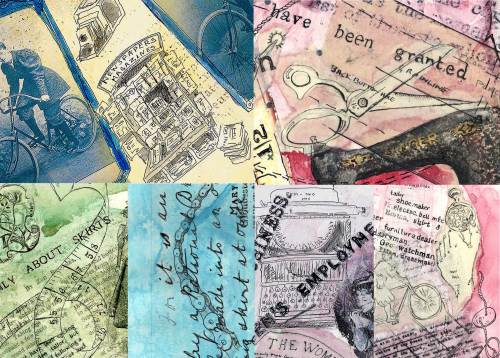Discovering Bikes and Bloomers
June 4, 2014 by aliceangus · 2 Comments
Over the last few weeks I have been drawing and painting a series works to be printed on silk and wool for a set of unique textile linings for Victorian ladies cycling garments; commissioned for the Freedom of Movement research project created by sociologist Katrina Jungnickel who is based at Goldsmiths, University of London. The drawings are inspired by Kats in-depth research and tell some of the stories behind each patent, the woman who invented it and the social, technological, physical and cultural challenges that early women cyclists had to face .
Through much of my work with Proboscis collaborating with communities, geographers, technologists and social scientists I’ve become interested in how drawing in public or amongst researchers can be a catalyst for conversation, observation and new analysis, revealing hidden connections and sparking alternative ways to interpret ideas and research. So, rather than being isolated from Kats research in my studio I decided to take the work to Kat’s space in the Sociology Department at Goldsmiths, and for the conversation this sparked to inform the content and feel of each drawing as it developed. Kat has a keen interest in making, craft and collaboration so at any time there was drawing, sewing, film-making, photography and desk based academic research all going on in the space. The finished linings are the a record of, and result of those intense drawing activities as well as an interpretation of the research.
One of the features of the cycling garments that attracted me to this project is that they convert from one type of garment to another. A long skirt might be folded, gathered or lifted up to above the knee by some mechanism of cords, buttons or hooks, to reveal bloomers worn underneath or perhaps a long coat on top; in another patent a skirt is taken off, to reveal bloomers, and worn as a cycling cape. In previous projects I’ve explored drawing and textiles, creating images that change or are revealed by the movement of the fabric so it was interesting to now do this with such rich research tied to the form of a historical garment and in conversation with the researcher and her team.
I was surprised to find out how controversial it was for women to cycle (particularly wearing bloomers), they were shouted and jeered at, refused entry to cafes, were socially shunned and had dirt thrown at them. The women who invented these garments had to be highly creative and balance the need for modesty with the need for free movement of the limbs and safety from fabric catching in the mechanism of the bicycle. Despite the privileged backgrounds of the very early cyclists (machines were expensive) I think these women must have had to display great courage and strength of purpose to push against convention, adopting and campaigning for women’s freedom to be accepted as cyclists, to race on cycles and wear clothing that allowed them more freedom.
The garments themselves will be worn and used for storytelling and presenting the research. You can see them in an exhibition at Look Mum No Hands from 7pm on the 13 June 2014 find out more at bikesandbloomers.com
Spring Update: what we are up to
May 20, 2014 by Giles Lane · 4 Comments
Over the past six months or so we have been developing some new partnerships and working on several collaborative projects:
Alice is collaborating with Dr Katrina Jungnickel of Goldsmiths College’s Department of Sociology (and a former Proboscis associate from earlier days) on the Bikes and Bloomers project. She has been creating a series of illustrations – inspired by Katrina’s research into early women’s cycling clothes and the “rational dress” movement – which are being digitally printed on fabrics as part of recreations of some of the early designs for freedom of movement in clothing.
Alice has also received an Artist in Residence award to collaborate with the Mixed Reality Lab at the University of Nottingham on their Aestheticodes project, embedding smart codes for visual recognition into drawings and exploring the properties of working with printed fabrics for physical and digital storytelling.
Giles has been continuing to select works from bookleteer for our monthly subscription service, the Periodical – ranging this year from a tactile history of an ancient Scottish kingdom, to works of new poetry and fiction, memoirs of growing up in Soho in the 1920 and 30s, to a republication of John Milton’s 1644 call for unlicensed printing (and a free press), Areopagitica. He is also running a series of Pop Up Publishing workshops in May for the LibraryPress project, introducing new people to bookleteer and self-publishing in public libraries in Hounslow, Islington & Wembley.


Giles has recently been collaborating with the Movement Science Group at Oxford Brookes University who are leading on the development of a Rehabilitation Tool for survivors of traumatic brain injury (TBI), which is being funded by the EU as part of the CENTER-TBI project.
Giles has also been developing a new collaboration with the ExCiteS (Extreme Citizen Science) research group at UCL to bring together the work he has been doing with Professor James Leach and the community of Reite in Papua New Guinea on Traditional Environmental and Cultural Knowledge (TEK), with ExCiteS work with forest-dwelling communities in Congo and elsewhere. We aim to develop a prototype for indigenous people to be able to digitally record and share knowledge using a combination of machine learning software, mobile devices and their own traditional craft and cultural practices. This is being developed alongside our planning for further field work in PNG to expand upon our pilot TEK toolkit experiments using hybrid digital/physical notebooks formats.








